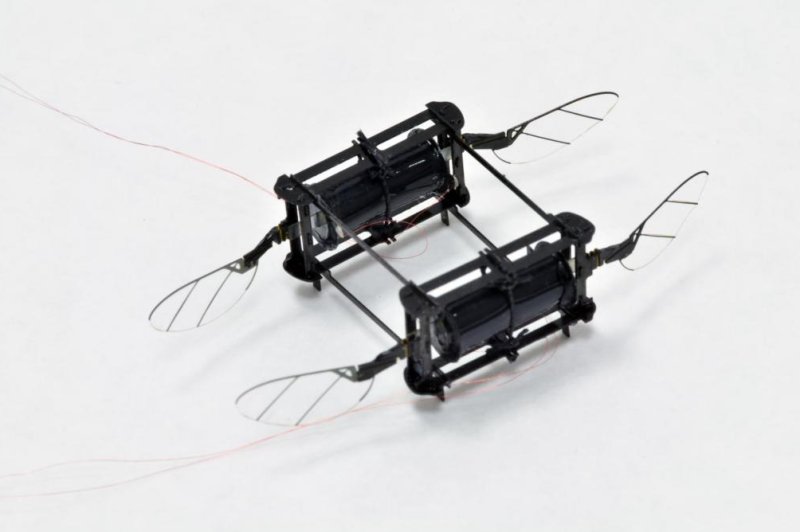Scientists used a new soft actuator material to build a four-wing flying microbot named Robobee. Photo by Harvard Microrobotics Lab
Nov. 4 (UPI) -- Engineers at Harvard University have unveiled a new flying robot powered by soft actuators. Because its muscles are soft, the insect-sized microbot, dubbed RoboBee, can survive collisions with walls, the floor and other Robobees.
"There has been a big push in the field of microrobotics to make mobile robots out of soft actuators because they are so resilient," Yufeng Chen, a former graduate student and postdoctoral fellow at the Harvard John A. Paulson School of Engineering and Applied Sciences, said in a news release. "However, many people in the field have been skeptical that they could be used for flying robots because the power density of those actuators simply hasn't been high enough and they are notoriously difficult to control. Our actuator has high enough power density and controllability to achieve hovering flight."
Chen and his colleagues at SEAS developed the robot using dielectric elastomers developed by David Clarke, a material scientist at Harvard. The dielectric elastomers offer insulation and deform when exposed to an electric current.
To improve the soft actuators power density, Chen and his colleagues tweaked the dielectric elastomer to boost the material's electrode conductivity. They also used a thread to build a lightweight support frame for the soft actuators, preventing the microbot's muscles from buckling -- a common problem for soft-bodied robots.
The researchers built a two wing prototype capable of taking off from the ground but without inflight maneuvering capabilities. They also built a four-wing model using two actuators, which can fly through crowded environs.
Though the soft actuators are easily replaceable and interchangeable, allowing researchers to quickly tweak and test different designs, there's no need to constantly replace damaged parts as a result of failed flights.
"One advantage of small-scale, low-mass robots is their resilience to external impacts," said Elizabeth Farrell Helbling, a former graduate student at SEAS. "The soft actuator provides an additional benefit because it can absorb impact better than traditional actuation strategies. This would come in handy in potential applications such as flying through rubble for search and rescue missions."
In a first-of-its-kind feat, scientists launched an eight-wing, four-actuator model that can hover like a helicopter and maneuver its way through crowded airspace. The team of engineers, including Chen and Helbling, described the novel microbot in a new paper published Monday in the journal Nature.
The study's authors are currently working to boost the energy efficiency of the soft actuators, in order to build a more powerful version of the RoboBee.















